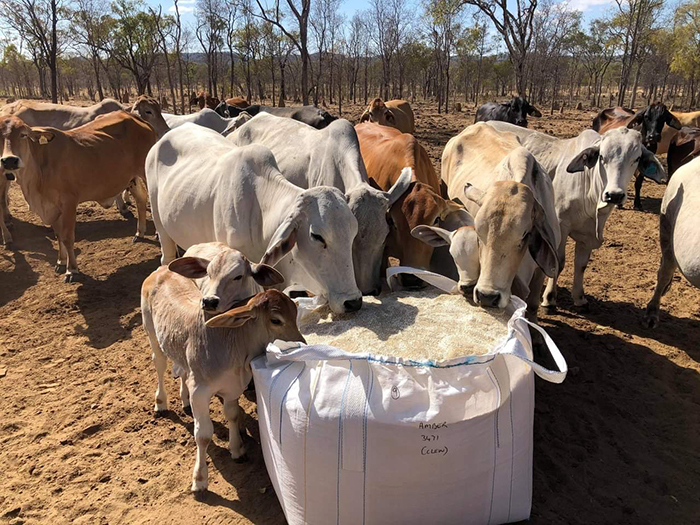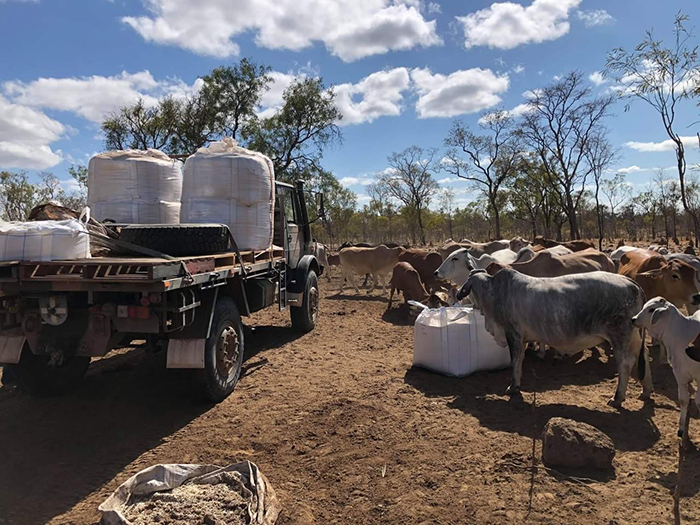Subscribe to The Weekly e-newsletter
News, views and advice delivered to your inbox every Friday. Covering producer case studies, industry news, market updates, on-farm tools and more, this e-newsletter is your one-stop shop for the latest in the red meat industry.
‘Amber Station’, Mount Surprise, Queensland
17 July 2023
Phosphorus supplementation can greatly improve herd performance of northern breeding operations and is a fundamental feature of a resilient livestock business. However, innovative supplement delivery technologies and persistence are necessary to overcome wet season property access challenges and to achieve sufficient P intakes across the herd.
‘Amber Station’ is a partly developed 104,000ha breeding property located 55km north of Mount Surprise, Queensland.
It was purchased by Werrington Cattle Company with the new managers, Georgia and Dan Slaney, taking up residence in late 2019.
Historically, Amber Station operated as a low-cost breeding operation producing weaners for transfer to other family properties.
At the time of purchase, about half the property was fenced into five large paddocks; the other half was open but linked to laneways and holding squares around strategic dams and water points. Steep gullies and rocky outcrops often acted as a natural boundary, and the number of neighbouring cattle running on Amber suggested minimal stock control.
An assessment of the breeding herd and calves purchased with the property indicated a P deficiency.
Werrington Cattle Co has a long history of successful wet season P and dry season supplementation of breeder herds, so the first management decision on Amber Station was to feed bulka bags of both wet and dry season supplement side-byside.
Two thousand cows purchased with the station consumed 22 tonnes of P supplement in just three weeks. Dan explained he had never seen such high intakes of P supplements.
Within weeks, they noticed a dramatic turnaround in the cattle condition which coincided with a significant reduction in supplement intakes.
Amber Station receives reliable wet season rainfall (~ 800mm) and is fortunate to have several creeks branching off the Lynd River which runs through Amber all year round. Along with a variety of native pastures and shrubs, Seca stylo and other introduced stylos are widespread. Ranges and rocky outcrops intersect the property and key soil types include decomposed granites, sandy country, watercourse frontages and some basalt soils. In addition to the river and natural springs, Amber has a house bore and 28 dams. The current property management plan focuses on implementing a P (wet and dry season) supplementation program and investing in yards, fences and water to improve the carrying capacity and running efficiency of Amber. Only breeders with better reproductive performance will be retained and herd bulls will be selected on objective criteria that focus on improving herd fertility, temperament and survivability.
An effective wet season P supplementation program provides intakes of 10g/day for each cow-calf unit during the wet season and targeted dry season supplementation (with P) for weaners and replacement heifers. Bulka bags are preferred because of the lack of lick sheds and poor wet season access — this delivery system has been successful for nearly two decades.
Using 250kg or 400kg bags allows a wider distribution of lick across each paddock when cattle are typically scattered due to surface water. Smaller 25kg bags are transported by helicopter to replenish existing lick sites when wet season vehicle access is limited.

Amber cows and calves consuming dry season supplement with P.
The Amber wet season P supplement recipe includes a mix of Kynofos 21™ (21% P), GranAm™, lime, Rumigro™ and salt. The aim is for breeders to consume around 100g/head/day of lick which, at 10% P (as fed), delivers the required 10g P/breeder/day. However, daily lick intakes can fluctuate during the wet season. GranAm™, a source of non-protein nitrogen, is used to help fill the protein gap as pasture quality declines later in the wet season. While used successfully in wet season P supplements on Werrington and Amber, GranAm™ is sour and can reduce supplement intake in some situations. Many northern producers are reluctant to use GranAm™ in their wet season supplements as target wet season P intakes are often difficult to achieve. In wet weather, inclusion of 5% lime helps form a surface crust and weatherproof the recipe.
The aim is for the Amber dry season urea-based supplements to include approximately 10–15% Kynofos 21™ which will supply around 3g and 5g P/head/day to heifers and breeders respectively during the dry season. Georgia and Dan observe cattle are less likely to gorge wet season P supplements when fed dry season licks with P in the months before the wet season, and that this results in steadier, but adequate, supplement intake over the growing season.
Georgia and Dan also believe the nitrogen component (urea equivalent) of GranAm™ may be exacerbating the hard crusting of their wet season bulka bag licks and will trial a new recipe by removing GranAm™ and adjusting the Kynofos 21™ and lime components. The Werrington Cattle Co team are very proactive in trialling new ideas to work out what best suits each enterprise and paddock situation.

Amber lick truck replenishing supplement supplies at lick sites.
Table CS5.1: The Amber wet season lick recipe is 10% P as fed and includes lime to waterproof the exposed bulka bags
|
Ingredient |
Inclusion rate |
|
GranAm™ |
12% |
|
Kynofos 21 |
48% |
|
Lime |
5% |
|
Rumigro |
0.5% |
|
Salt |
34.5% |
The Amber breeder management strategy requires regular pregnancy testing of all breeders. This, combined with a successful P supplementation program, better cattle control, and selection for fertility will allow the mating period to be progressively shortened. These strategies aim to achieve a female mortality rate of 2% in the long term, as well as produce a more consistent line of heavier weaner steers available for transfer to other properties within the family business.
The plan includes investments in additional fencing and property infrastructure to allow pasture spelling, less grazing pressure on parts of the property and an expansion of the herd over the next decade. Rebuilding the existing yards and cattle handling infrastructure will improve the safety of staff and ease of livestock handling. Upgrading and adding to existing station roads will improve access throughout the property for more of the year.
An economic analysis completed in 2020 as part of this case study indicates the expected return to the total funds invested in the property purchase, livestock, plant and equipment and property development, over the first decade could average 4–5%/year using long-term cattle prices and costs.
This estimate did not include any allowance for a potential change in the value of the land component of the investment.
An estimated comparison between Amber with little to no P feeding and Amber at the end of the five-year development plan with full P supplementation of the Amber herd was undertaken.
The benefits of feeding P include:
- an increase in weaning rates from 47% to 66% – in 2022, rates rose to 83%
- a reduction in breeder deaths from 8% to 2%
- improved female and steer cattle weights and a subsequent increase in the value of these cattle
- higher weaner rates.
The overall contribution of P supplementation to the predicted increase in gross margin/adult equivalent on Amber is significant. Since this analysis was done in 2020, Dan is pleased to report that he has seen ongoing improvements.
Table CS5.2: A modelled comparison of the herd performance, turn-off age, turn-off value and gross margins with, and without, wet season P supplementation between a typical northern Gulf property and after the implementation of the Amber five-year property development plan
|
Amber without P |
Amber with P and development (2020) |
|
|
Total adult equivalents |
5,200 |
8,742 |
|
Total cattle carried |
6,196 |
8,259 |
|
Total breeders mated and kept |
4,158 |
4,860 |
|
Total calves weaned |
2,012 |
3,945 |
|
Weaners/total cows mated |
47% |
66% |
|
Overall breeders deaths |
8% |
2% |
|
Female sales/total sales |
34% |
48% |
|
Total cows and heifers sold |
519 |
1,810 |
|
Total steers sold |
1,006 |
1,972 |
|
Average female price |
$696 |
$774 |
|
Average steer price |
$366 |
$428 |
|
Direct costs excluding bulls |
$104,307 |
$475,747 |
|
Bull replacement |
$78,359 |
$96,842 |
|
GM per adult equivalent |
$105 |
$191 |


